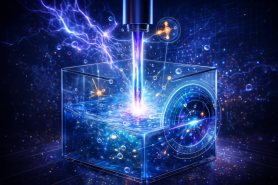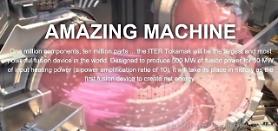
[Courtesy of the National Fusion Research Institute]
ITER experiments will take place inside a hermetically sealed steel container that acts as a first safety containment barrier. In its doughnut-shaped chamber, plasma particles spiral around continuously without touching the walls. The vacuum vessel provides a high-vacuum environment, improves radiation shielding and plasma stability, and acts as the primary confinement barrier for radioactivity.
The vacuum chamber is made up of nine sectors. Hyundai Heavy Industries (HHI) is in charge of four sectors -- first, sixth, seventh and eighth. The remainder has been built in the European Union.
The National Fusion Research Institute (NFR) held a ceremony on Monday at HHI's base in the southeastern port city of Ulsan to mark the completion of Sector 6, which is the reference point for installing the vacuum container. Only when it is successfully installed, other sectors can be installed sequentially.
"We are happy to overcome many technical limitations and complete Sector 6 in 10 years," HHI CEO Han Young-seok said. "We will also procure the remaining three sectors in a timely manner to contribute to the successful construction of ITER." HHI said it has succeeded in implementing a perfect vacuum by precisely welding a double bulkhead structure of 60mm thick special stainless steel material.
Seven countries including South Korea, the United States, China and EU members have been involved in the ITER project. If the experiment is successful, it could provide mankind with a limitless energy source. Plasma experiments will begin in 2025 and full deuterium-tritium fusion experiments in 2035.
Fusion power, generated by nuclear fusion, has long been spotlighted as a safe next-generation power source capable of reducing radioactivity. However, commercialization has a long way to go because it's extremely difficult to produce a state of controlled fusion. A tokamak to be housed in a seven-story structure in reinforced concrete is an experimental machine designed to harness the energy of fusion.
The ITER vacuum vessel with an interior volume of 1,400 m³ will measure 19.4 meters in outer diameter, 11.4 meters high, and weigh about 5,200 tons. In a tokamak device, the larger the vacuum chamber volume, the easier it is to confine the plasma and achieve the type of high energy regime that will produce significant fusion power.
Copyright ⓒ Aju Press All rights reserved.



